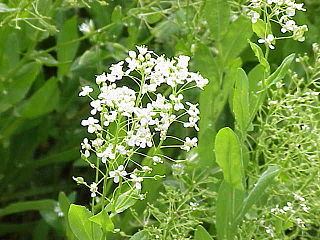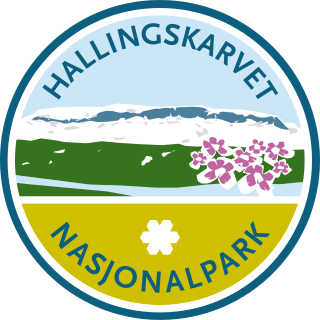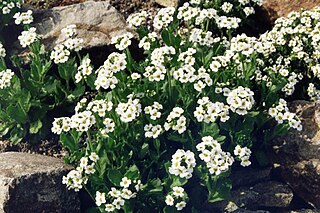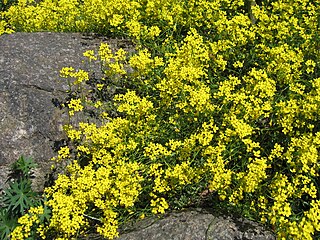There are over 190 vascular plant species on the Norwegian Arctic archipelago of Svalbard. This figure does not include algae, mosses, and lichens, which are non-vascular plants. For an island so far north, this number of species constitutes an astonishing variety of plant life. Because of the harsh climate and the short growing season, all the plants are slow growing. They seldom grow higher than 10 cm (4 in)

Lepidium is a genus of plants in the mustard/cabbage family, Brassicaceae. The genus is widely distributed in the Americas, Africa, Asia, Europe, and Australia. It includes familiar species such as garden cress, maca, and dittander. General common names include peppercress, peppergrass, pepperweed, and pepperwort. Some species form tumbleweeds. The genus name Lepidium is a Greek word meaning 'small scale', which is thought to be derived from a folk medicine usage of the plant to treat leprosy, which cause small scales on the skin. Another meaning is related to the small scale-like fruit.

Draba is a large genus of flowering plants in the family Brassicaceae, commonly known as whitlow-grasses.

Draba aizoides is a species of flowering plant in the family Brassicaceae, known as yellow whitlow-grass. It is native to Europe where it is found on limestone rocks and walls. In the British Isles it is found only on the Gower Peninsula in Wales.

Lepidium draba, also known as whitetop, hoary cress, or Thanet cress, is a rhizomatous perennial flowering plant in the family Brassicaceae. It is native to western Asia and southeastern Europe and has been widely introduced elsewhere.

Hallingskarvet National Park is a national park in central Norway that was established by the government on 22 December 2006. The park is located in the municipalities of Hol, Ulvik and Aurland. More precisely, the park comprises the Hallingskarv plateau and the high mountain areas to the west of it. It includes the Vargebreen glacier as well as the valleys of Såtedalen, Lengjedalen, Ynglesdalen, and parts of Raggsteindalen.

Draba verna, common whitlowgrass, is a species of plant in the cabbage family. It is a small spring-flowering annual which is widely dispersed around the world, and which is found on walls, pavements and patches of bare ground. It has a complex taxonomy which is not yet fully elucidated.
Draba splendens is a species of flowering plant in the family Brassicaceae. It is found only in Ecuador. Its natural habitats are subtropical or tropical high-altitude grassland and rocky areas. It is threatened by habitat loss.
Draba californica is a species of flowering plant in the family Brassicaceae, known as the California draba.
Draba subumbellata is a species of flowering plant in the family Brassicaceae known by several common names, including parasol draba, mound draba, and White Mountains cushion draba. This small perennial plant is native to the White Mountains which straddle the California-Nevada state line and the Inyo Mountains nearby. It lives on barren rocky scree above 3000 meters.

Draba fladnizensis is a species of plant in the family Brassicaceae known by the common names arctic draba, Austrian draba, and white arctic whitlow-grass. It has a circumpolar distribution, occurring throughout the northern latitudes of the Northern Hemisphere. It is present in Europe, Asia, and North America from Alaska across northern Canada to Greenland. Its distribution extends south through the higher elevations in the Rocky Mountains to Colorado and Utah. It is common and widespread in the Canadian Arctic Archipelago, occurring on several Arctic islands including Baffin, Devon, and Ellesmere Islands. It is named after the Austrian village of Flattnitz, in the Gurktaler Alpen.
Draba exunguiculata is a species of flowering plant in the family Brassicaceae known by the common names clawless draba and Grays Peak draba. It is endemic to Colorado in the United States.

Draba globosa is a species of flowering plant in the family Brassicaceae known by the common names beavertip draba, round-fruited draba, and rockcress draba. It is native to the western United States, where it occurs in Idaho, Montana, Utah, Wyoming, and possibly Colorado.
Draba graminea is a species of flowering plant in the mustard family known by the common names Rocky Mountain draba and San Juan Whitlow-grass. It is endemic to the state of Colorado in the United States, where it is limited to the San Juan Mountains.

Draba reptans, common names Carolina draba, Carolina whitlow-grass, Creeping whitlow-grass, and Whitlow-grass, is an annual plant in the family Brassicaceae that is native to North America.

Draba sibirica is a species of flowering plant belonging to the family Brassicaceae.

Draba corymbosa is a species of flowering plant belonging to the family Brassicaceae.

Draba nemorosa is a species of flowering plant belonging to the family Brassicaceae.

Draba incana L. — Drave blanchâtre. —, is a species of flowering plant belonging to the family Brassicaceae.
Draba caswellii, also known as Caswell's draba, is a species of plant of the Draba genus. It is endemic to the Kluane National Park in the alpine tundra on the Yukon, Canada. It is listed as critically imperiled by NatureServe. Most closely resembles D. porsildii, it differs by having soft, crisped trichomes throughout.












